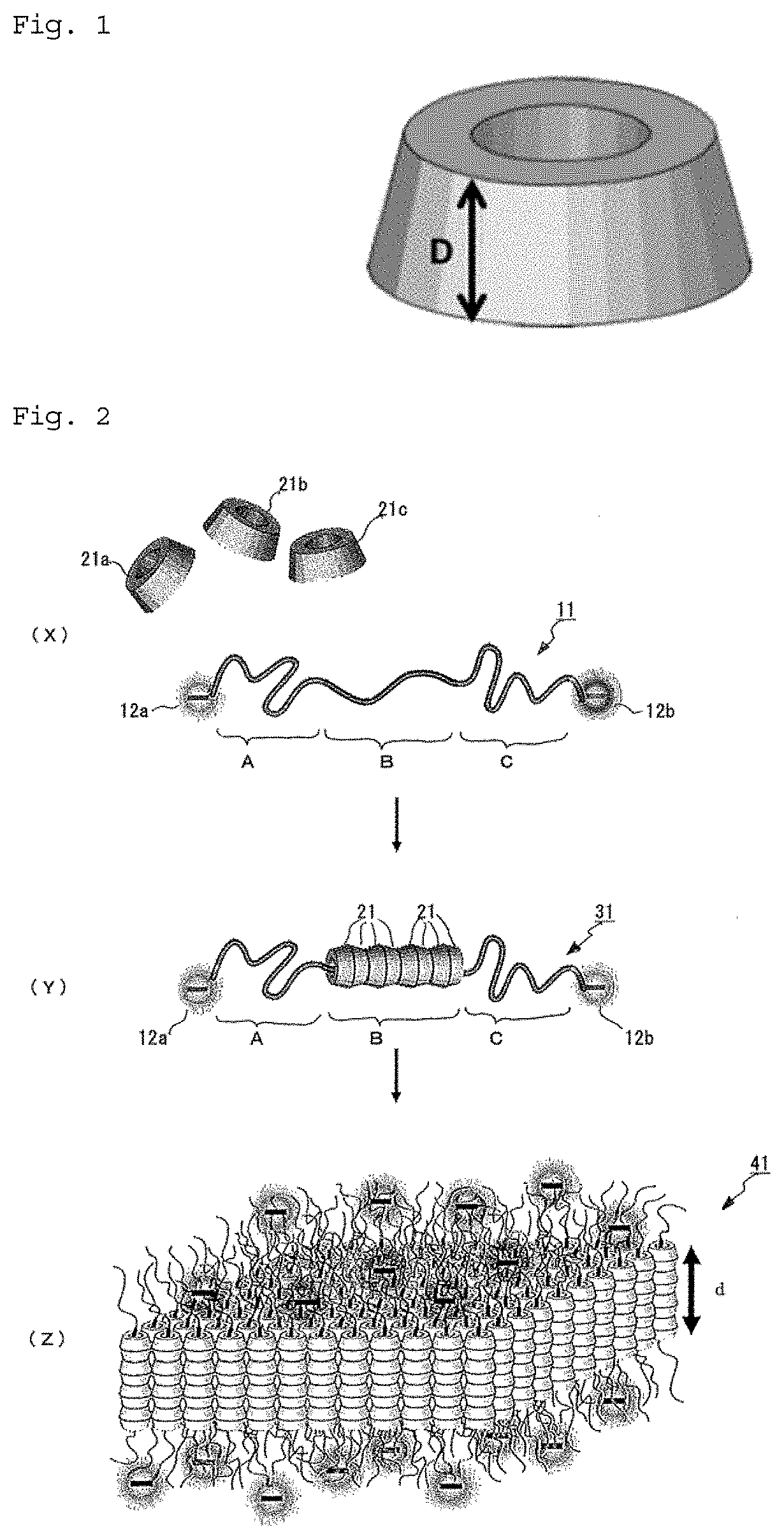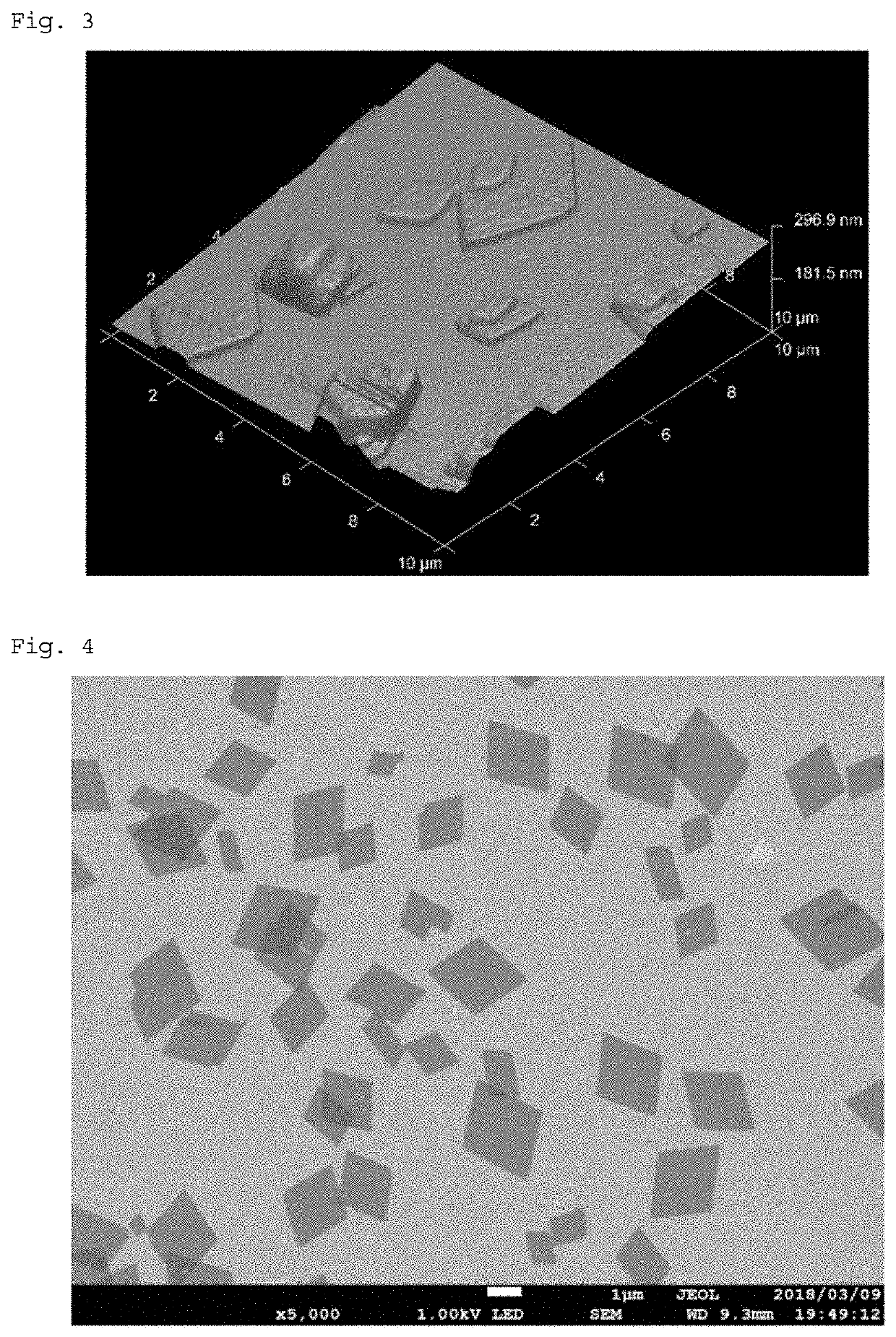Isolated nanosheet and production method thereof
- Summary
- Abstract
- Description
- Claims
- Application Information
AI Technical Summary
Benefits of technology
Problems solved by technology
Method used
Image
Examples
synthesis example 1
s-Carboxylated Polyethylene Glycol-Block-Polypropylene Glycol-Block-Polyethylene Glycol
[0212]α,ω-Bis-hydroxy polyethylene glycol-block-polypropylene glycol-block-polyethylene glycol (Pluronic (trademark) F68; PEO76PPO29PEO76, Mw=8,400 g / mol; 2.50 g, 0.30 mmol), 2,2,6,6-tetramethylpiperidine 1-oxyl (TEMPO; 203 mg, 1.30 mmol), and sodium bromide NaBr (202 mg, 1.96 mmol) were dissolved in 28 mL of water. After that, while the solution was stirred, a 5 wt % aqueous solution of sodium hypochlorite was slowly added dropwise until the pH value ceased to change. The resultant aqueous solution was further stirred at room temperature for 10 minutes. After that, 2.5 mL of ethanol was put into the solution to quench the reaction. Further, a 6 M aqueous solution of hydrochloric acid was put into the solution until the pH reached 2, and the target product was extracted with 40 mL of methylene chloride. Further, the resultant methylene chloride solution was washed twice with a 0.01 M aqueous solut...
synthesis example 2
s-Amino Polyethylene Glycol-Block-Polypropylene Glycol-Block-Polyethylene Glycol
[0213]A solution of α,ω-bis-hydroxy polyethylene glycol-block-polypropylene glycol-block-polyethylene glycol (Pluronic (trademark) F68; PEO76PPO29PEO76, Mw=8,400 g / mol; 1 g, 0.119 mmol) in 10 mL of tetrahydrofuran was prepared, and added dropwise to a separately procured solution of 0.212 g (1.31 mmol) of 1,1′-carbonyldiimidazole in 6.3 mL of tetrahydrofuran. The resultant solution was further stirred at room temperature overnight, and then added dropwise to ethylenediamine (794 μL, 11.9 mmol). After the completion of the reaction, tetrahydrofuran was evaporated, and the resultant white solid was dissolved in water and then purified by dialysis. After the purification, water was removed by freeze-drying to afford the target product (0.92 g, 92%).
synthesis example 3
s-Carboxylated Polyethylene Glycol
[0214]10 g of α,ω-bis-hydroxy polyethylene glycol was dissolved in 100 mL of water, and 2,2,6,6-tetramethylpiperidine 1-oxyl (TEMPO; 100 mg, 0.64 mmol) and sodium bromide (100 mg, 0.97 mmol) were put into the solution. After that, while the solution was stirred, a 5 wt % sodium hypochlorite aqueous solution was slowly added dropwise until the pH reached a value of from 10 to 11, followed by stirring at room temperature for 15 minutes. 10 mL of ethanol was put into the solution, and the pH of the solution was adjusted to 2 or less with a dilute hydrochloric acid solution to quench the reaction, followed by extraction with methylene chloride. Methylene chloride was evaporated under reduced pressure, followed by recrystallization from 250 mL of ethanol to afford the target product with a yield of 99% or more.
PUM
| Property | Measurement | Unit |
|---|---|---|
| Thickness | aaaaa | aaaaa |
| Thickness | aaaaa | aaaaa |
| Thickness | aaaaa | aaaaa |
Abstract
Description
Claims
Application Information
 Login to View More
Login to View More - R&D
- Intellectual Property
- Life Sciences
- Materials
- Tech Scout
- Unparalleled Data Quality
- Higher Quality Content
- 60% Fewer Hallucinations
Browse by: Latest US Patents, China's latest patents, Technical Efficacy Thesaurus, Application Domain, Technology Topic, Popular Technical Reports.
© 2025 PatSnap. All rights reserved.Legal|Privacy policy|Modern Slavery Act Transparency Statement|Sitemap|About US| Contact US: help@patsnap.com



